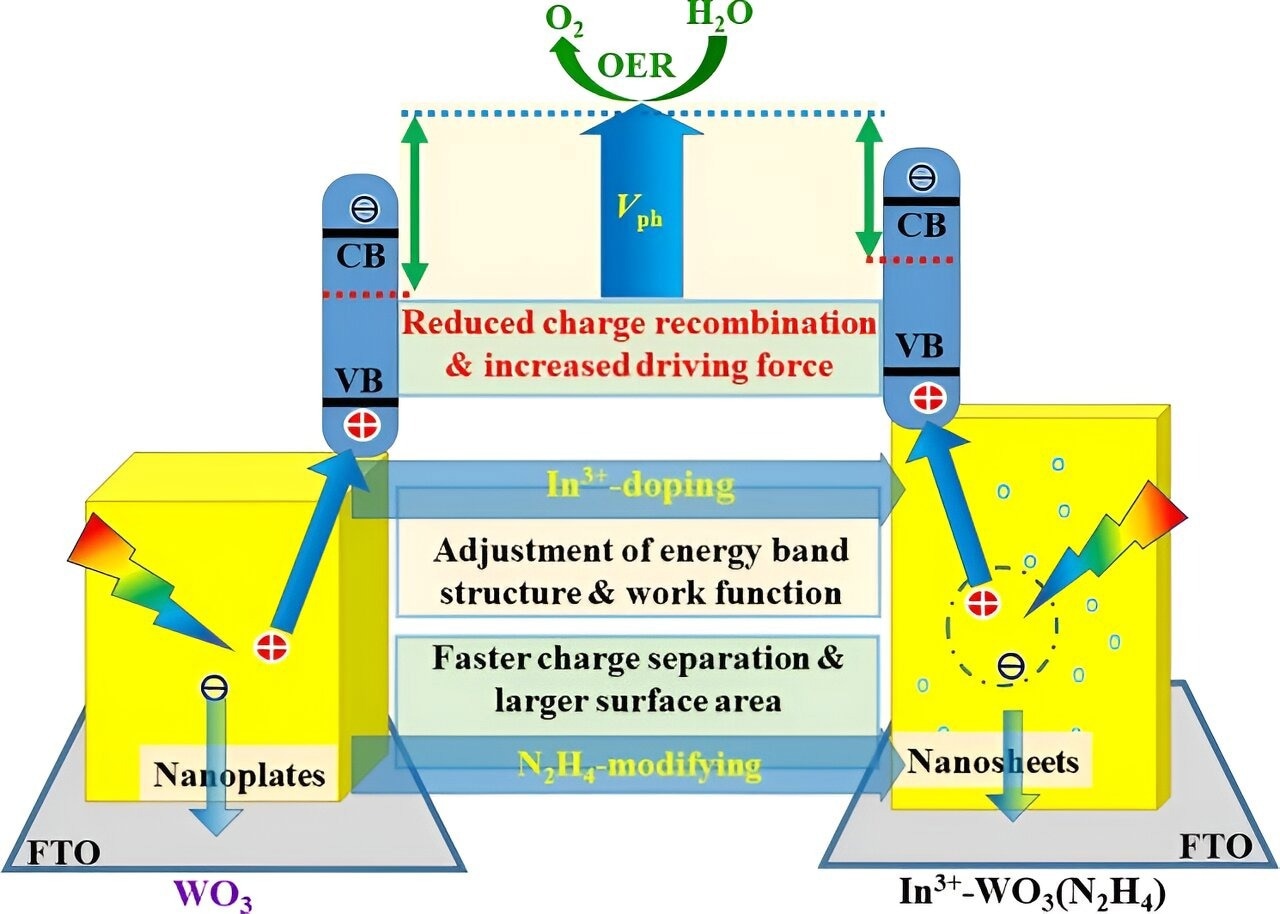A novel nanostructured WO3-based photoanode was prepared hydrothermally at 160 °C and then calcined at 500 °C, according to a recent study led by Associate Professor Peng Zeng of Zhaoqing University’s School of Food and Pharmaceutical Engineering and Professor Tianyou Peng of Wuhan University’s College of Chemistry and Molecular Sciences.
 Hydrazine hydrate in the hydrothermal solution promotes the formation of layered WO3 film stacked by (020) facet-exposed nanosheets, while In3+-doping optimize the electronic band structure of WO3 to enhance the OER driving force. Image Credit: Science China Press
Hydrazine hydrate in the hydrothermal solution promotes the formation of layered WO3 film stacked by (020) facet-exposed nanosheets, while In3+-doping optimize the electronic band structure of WO3 to enhance the OER driving force. Image Credit: Science China Press
Furthermore, the study examined the impact mechanism of hydrazine hydrate and In3+–doping on the WO3 photoanode’s microstructure, photoelectrochemical behavior, electronic band structure, and work function.
Science China Chemistry published the findings.
As a result of adding hydrazine hydrate as a texture regulator to the hydrothermal reaction solution, layered WO3 film stacked by (020) facet-exposed nanosheets with ~300 nm length (along the [200] direction) and ~150 nm width (along the [002] direction) was formed. The experiment’s results demonstrate the close relationship between the photocurrent density and stability of the nanostructured WO3 photoanode and its microstructure, morphology, and electronic band structure.
While In3+–doping optimizes the electronic band structure of WO3, resulting in a negatively shifted flat band potential and lowered work function to enhance the driving power of OER, this enhances the specific surface area and reactive sites to facilitate charge transfer and separation.
In comparison to In3+–ions, the addition of hydrazine hydrate improves photocurrent density, applied bias photon-to-current efficiency (ABPE), incident-photon-to-current conversion efficiency (IPCE), photoelectrochemical durability, and Faraday efficiency for O2 evolution more significantly.
The OER performance of the In3+–WO3(N2H4) photoanode was greatly increased due to the synergistic effect of hydrazine hydrate modification and In3+-doping.
The optimized In3+-WO3(N2H4) photoanode displayed an IPCE of 38.6% (at 410 nm) and a photocurrent density of 1.93 mA cm–2 under conditions of AM1.5G simulated sunlight illumination, Na2SO4 solution, and 1.23 V vs. RHE, which are 2.8 and 3.0 times that of the pure WO3 photoanode, respectively.
This OER performance of In3+-WO3(N2H4) is equivalent to, if not better than, that of most reported WO3-based photoanodes, showing its potential for practical application in PEC water splitting. This study proposes a potential technique for improving the PEC OER performance of nanostructured WO3 photoanodes by modifying their microstructure and incorporating heteroatoms.
Journal Reference:
Zeng, P., et al. (2023) Architecture modification and In3+-doping of WO3 photoanodes to boost the photoelectrochemical water oxidation performance. Science China Chemistry. doi:10.1007/s11426-023-1691-1